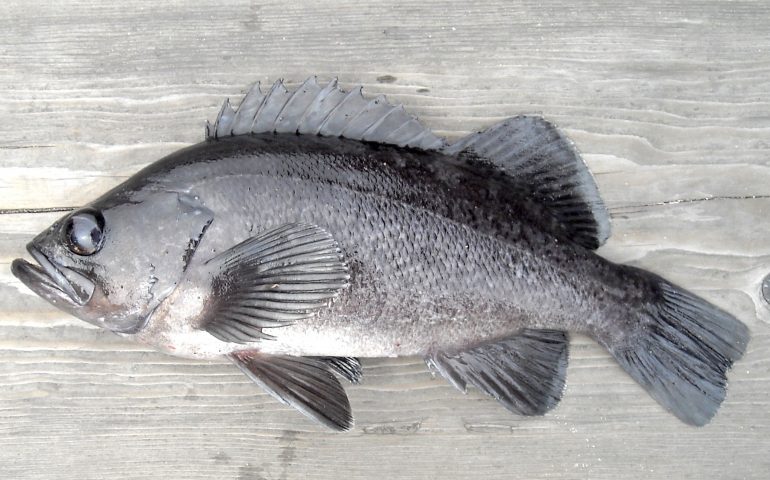Scorpionfishes and Rockfishes: Family Scorpaenidae
Species: Sebastes melanops (Girard, 1856); from the Greek words sebastes (magnificent), melas (black), and ops (face).
Alternate Names: Commonly called black bass, bass rockfish or black snapper; also confused with and called blue rockfish; sometimes called bluefish, Columbia River rockfish, gray rockfish, Pacific snapper, black rock cod; Commercial fishermen once called these nero (black in Italian), cherna (a Portugese fish), or pesce pretre (used in Monterey).
Identification: Typical bass-like shape. Their coloring is black or blue-black, and white below. There are usually black spots on the back, up onto the lower parts of the dorsal fin (no spots on the dorsal fin of blue rockfish). Often confused with blue rockfish but can be differentiated from the blues by the following: in black rockfish the upper jaw extends to or past the rear of the eye and the anal fin is rounded.
Size: To 27.6 inches and 11 pounds. Most caught from piers are under a foot in length. The California angling record weighed 9 lb 2 oz and was caught near the San Francisco Light Station in 1988. The diving record fish weighed 8 Lbs 3 oz and was taken at Shell Beach, Sonoma Co. in 2008.
Range: Northern Baja California to Amchitka Island and Rat Island in the Aleutian chain, Alaska, and the southern Bering Sea. Common from south of Santa Cruz, central California, to Kodiak Island, Gulf of Alaska.
Habitat: Generally found in shallow water rocky areas and reefs down to 120 feet although they’ve been taken to 1,200 feet deep. An opportunistic predator that primarily feeds mid-water to the top on other fish and zooplankton although they will also head down to the bottom to feed on shrimp, crabs and octopi.
Piers: Black rockfish, especially juveniles, are caught at most piers north of San Francisco. Best bets: San Francisco Municipal Pier, Point Arena Pier, Eureka Municipal Boardwalk, Trinidad Pier and Citizens Dock (Crescent City).
Shoreline: A common catch by rocky shore anglers in northern California.
Boats: Black rockfish are the most frequently taken rockfish by recreational anglers (boating) from Eureka to Crescent City and generally among the top ten species between San Francisco and Fort Bragg.
Bait and Tackle: Most of the black rockfish caught by pier anglers are young fish hooked while the anglers are fishing around the pilings for perch or other bottom fish. Most are landed on high/low leaders using small hooks. Some are caught on bait-rigs that anglers use in pursuit of jacksmelt, walleye surfperch, herring, or even anchovies; this is most common at Eureka and Crescent City. If the pier isn’t crowded, an angler should try artificial lures such as small swimbaits.
Food Value: An excellent eating, mild-flavored fish that is somewhat soft textured with small flakes and moderate fat content. Suitable for all methods of cooking but best when fresh because the fat becomes rancid rather quickly.
Comments: Black rockfish live to be about 50 years old; a few mature (reproductive) at about ten inches in length and 3 years of age, most are mature at about 14 inches and 6-7 years in age; all are mature by 17 inches and 9 years in age.

I was using grass carp as bait and cought a 12 inch black rock cod in moss landing California